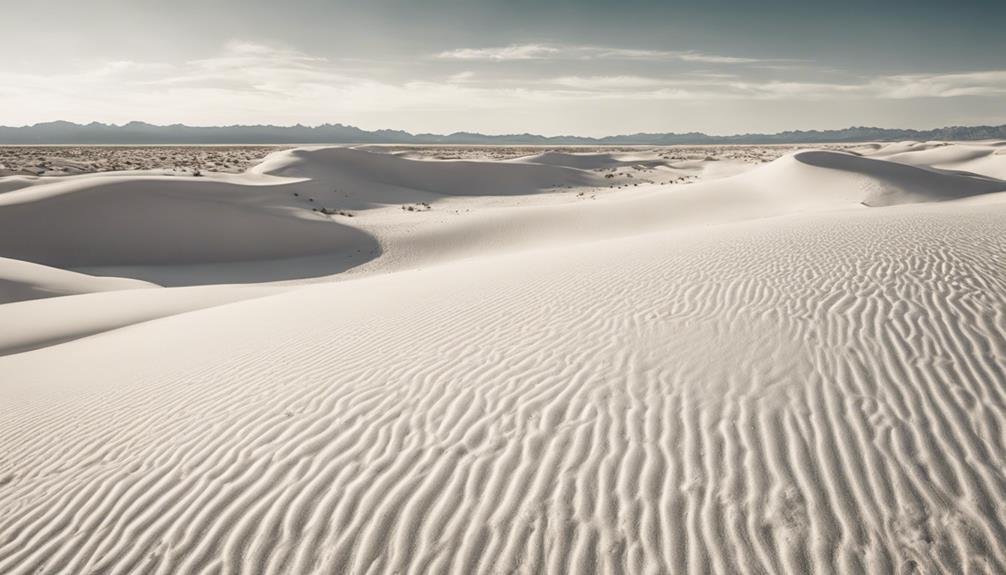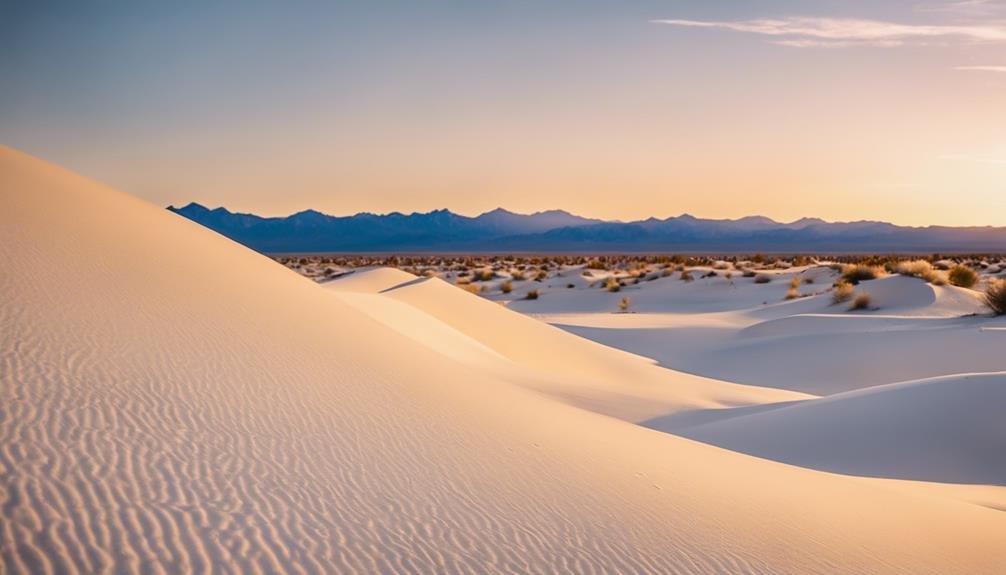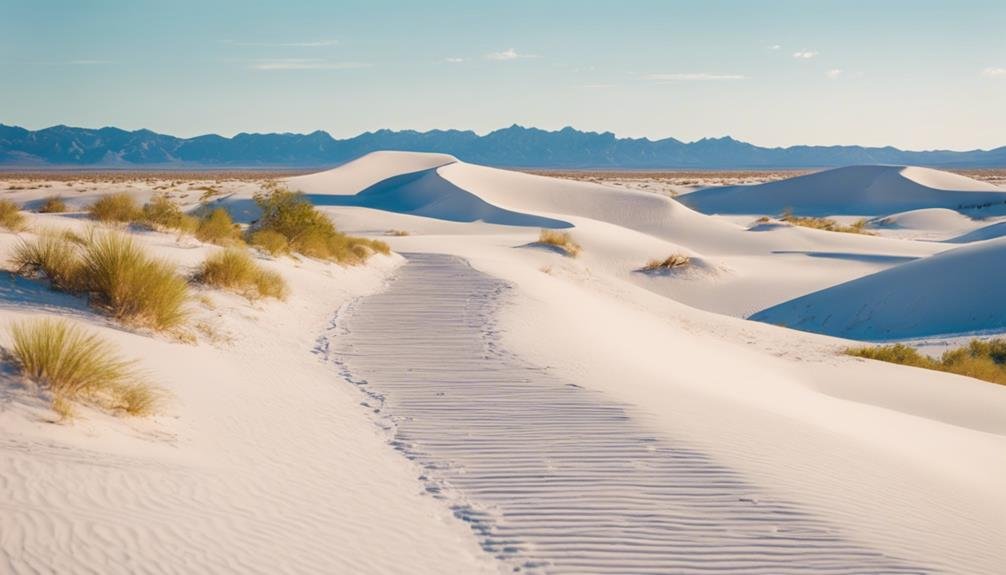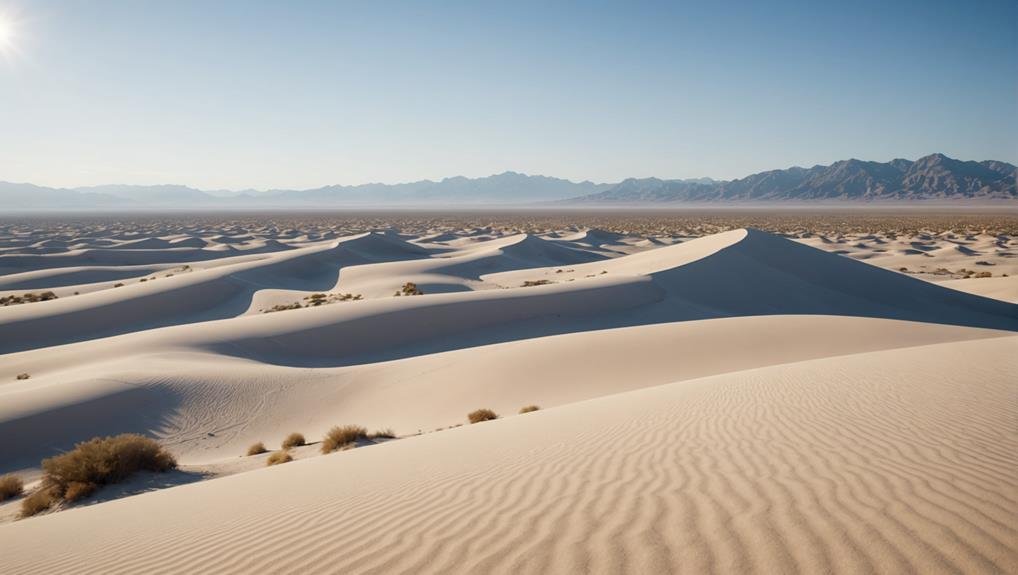When you visit White Sands National Park, you’ll find yourself in the heart of the Tularosa Basin, surrounded by the world’s largest gypsum dune field with dunes soaring up to 60 feet. It’s a place where you can engage in unique activities like sand sledding and hiking along diverse trails.
The park’s rich ecosystem, featuring endangered species and various plants, adds another layer to your adventure. But what’s the history behind these striking landscapes, and how do they shape the experience? Let’s explore further to uncover these hidden stories.
Key Takeaways
- White Sands National Park features the world’s largest gypsum dune field, spanning 145,762 acres in Tularosa Basin, New Mexico.
- Popular activities include sand sledding, hiking, backcountry camping, and ranger-led programs like the sunset stroll.
- Unique wildlife includes kit foxes, kangaroo rats, bleached earless lizards, and over 200 bird species.
- The park charges a $25 entrance fee per vehicle, valid for 7 days, with free entry for pass holders.
- Park hours are daily from 7:00 a.m. to 30 minutes after sunset, with essential gear recommended for safety.
History

White Sands National Park’s history is rich and ancient, evidenced by the oldest human footprints in North America, dating back 21,000-23,000 years. As you explore the park, you’re stepping into a landscape once home to Paleo-Indians.
These early hunters used stone tools to track and hunt megafauna like mammoths and bison, whose footprints have also been found in the area. Imagine the Tularosa Basin alive with these enormous creatures and those who relied on them for survival.
Following the Paleo-Indians, the Archaic people continued to inhabit this region, adapting their lifestyles as the climate and environment changed. The Jornada Mogollon people later settled in the basin, leaving evidence of their sophisticated culture.
Their presence is marked by remnants of their dwellings and artifacts, showing how they thrived in this unique landscape. Over 700 years ago, the Apaches migrated into the Tularosa Basin, following the bison herds essential to their way of life. The park’s history is a fascinating tapestry woven from the lives of these diverse groups, whose footprints and artifacts provide a glimpse into their ancient world.
Geography and Climate
Nestled in New Mexico’s Tularosa Basin, the park spans 145,762 acres and boasts the world’s largest gypsum dune field. The dunes can reach up to 60 feet high, and about 4.5 billion short tons of gypsum sand create a mesmerizing and unique landscape. These gypsum dunes formed due to historical climate changes, making the park a natural wonder.
The park’s climate is as varied as its landscape. Temperatures can plummet below freezing in winter and soar above 100°F in summer. This extreme temperature range adds another layer of complexity to the park’s environment, contributing to its geographical significance.
The White Sands Missile Range and Holloman Air Force Base border White Sands National Park. This proximity not only highlights the park’s importance but also its strategic geographical significance. Here’s a quick breakdown to help you visualize the park’s geographical and climatic features:
| Feature | Description |
|---|---|
| Location | Tularosa Basin, New Mexico |
| Area | 145,762 acres |
| Dunes | Up to 60 feet high |
| Sand Composition | Gypsum sand |
| Temperature Range | Below freezing in winter to over 100°F in summer |
| Nearby Installations | White Sands Missile Range, Holloman Air Force Base |
White Sands National Park’s unique landscape and dynamic climate make it a must-see destination.
Activities and Attractions

Beyond the park’s enchanting geography and climate, there’s a myriad of activities and attractions that await visitors. One highlight is sand sledding on the world’s largest gypsum dune field—an exhilarating experience you won’t forget. If you’re up for a hike, the park offers five main hiking trails, each varying in length and difficulty.
These trails provide a fantastic way to explore the stunning landscapes. For those seeking a more immersive experience, backcountry camping is available. You can sleep under the stars with breathtaking dune views. The park also offers ranger-led programs, including the popular sunset stroll, where you can learn about the park’s unique features while enjoying a stunning sunset.
Driving through the park is a must, and Dunes Drive, an 8-mile access road, offers scenic views and easy access to trailheads and picnic areas. Don’t forget to stop by the visitor center to gather information and plan your visit. Nature walks provide an excellent opportunity to explore the park more relaxed and appreciate its beauty at a slower pace. With so much to do, White Sands National Park promises an unforgettable adventure.
Wildlife and Ecology
Discover the fascinating wildlife and unique ecological adaptations thriving in the gypsum dune field of White Sands National Park. This distinct habitat hosts a variety of plants and animals that have evolved to survive the harsh desert environment. You’ll encounter unique plant and animal life, including kit foxes, kangaroo rats, and bleached earless lizards perfectly adapted to the park’s challenging conditions.
White Sands National Park’s ecosystem is incredibly diverse, boasting over 800 species of insects. These insects have developed specialized adaptations to thrive in the gypsum sand. The park also provides a critical refuge for endangered species like the white sands pupfish and the dunes sagebrush lizard, highlighting its importance for conservation.
Bird enthusiasts will be thrilled by the park’s rich avian life. You can spot over 200 bird species, including roadrunners, burrowing owls, and various migratory birds that pass through the area. This diverse wildlife makes White Sands a prime location for birdwatching.
The unique plant and animal life and the park’s distinct habitat create a vibrant and complex ecosystem. It’s a testament to nature’s resilience and adaptability in one of the planet’s most extreme environments.
Visitor Information

When planning your visit to White Sands National Park, you’ll find essential information to make your trip enjoyable and safe. The entrance fee is $25 per vehicle for seven days, but you can enter for free if you have an America the Beautiful pass or an annual park pass. The park is open daily from 7:00 a.m. until 30 minutes after sunset, perfect for a weekend or two full days of exploration.
Ensure to bring essential items such as a hat, sunglasses, sunscreen, a jacket, a GPS tracker, and ample water, especially during hot weather. The park offers only 10 camping sites for those interested in backcountry camping, which is ideal for experienced campers seeking a unique overnight experience.
| Visitor Information | Details |
|---|---|
| Entrance Fee | $25 per vehicle for 7 days, free with America the Beautiful pass or annual park pass |
| Park Hours | Daily from 7:00 a.m. until 30 minutes after sunset |
| Essential Items | Hat, sunglasses, sunscreen, jacket, GPS tracker, ample water |
To explore the park, drive along the 8-mile Dunes Drive, the only access road, with the first 4 miles paved and the rest packed with gypsum sand, allowing for a scenic drive through the park’s stunning landscape.
Conclusion
You’ll fall in love with White Sands National Park. Its breathtaking gypsum dunes, rich wildlife, and endless activities make it a must-visit destination. Whether hiking, sand sledding, or just soaking in the scenery, there’s something for everyone.
The unique blend of history, geography, and natural beauty guarantees a memorable experience. Don’t miss the chance to explore this incredible park and create unforgettable memories. Pack your bags and get ready for an adventure you won’t forget!

